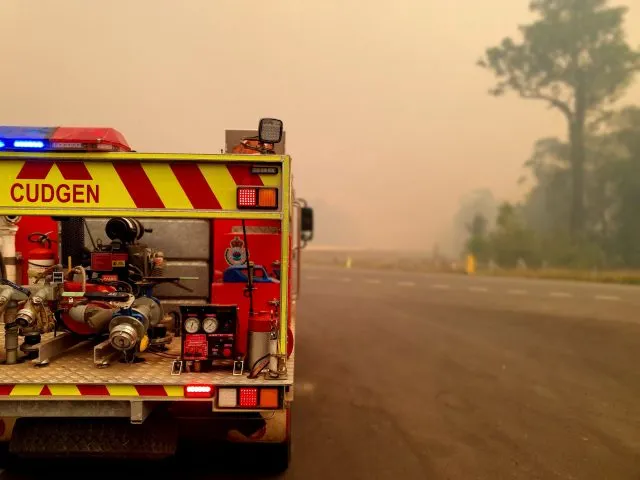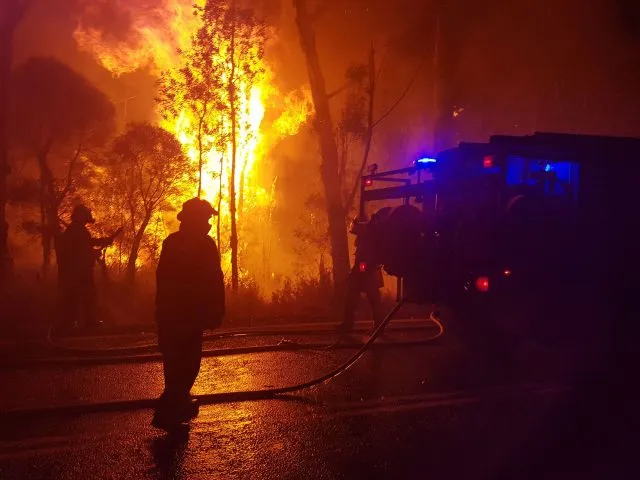
Brought to you by Cosmos Magazine and The Echo
More evidence that the smoke from the fires may have prolonged the life of the hole in the ozone layer.
Australia’s devastating Black Summer bushfires released smoke particles into the Earth’s upper atmosphere, contributing to the highest stratospheric temperatures in three decades.
Scientists believe the impact may have prolonged the life of the hole in the ozone layer.
The 2019-20 bushfires burned more than 24 million hectares, directly caused 33 deaths and killed or displaced an estimated three billion animals.
The fires released millions of tonnes of smoke aerosols, and researchers from the UK have found a significant amount reached the lower stratosphere, about 15 kilometres above the ground.
The study, published in Nature Scientific Reports, links the smoke aerosols to abnormally high stratospheric temperatures, which were the highest recorded since the early 1990s.
The authors report an initial plume of smoke reached an altitude of 16 kilometres on December 31, 2019 followed by a similar plume on January 12, 2020. The smoke aerosols eventually reached altitudes of 25 to 35 kilometres detected throughout 2020.
Read more: Fire and rain and the smoke that lingers

Using data from the CALIPSO and Suomi National Polar-orbiting Partnership satellites to monitor aerosol levels in the stratosphere in the southern hemisphere between December 2019 and 2020, the researchers concluded the smoke aerosols emitted from the Australian bushfires led to increased stratospheric temperatures of about 0.7 degrees Celsius.
The study backs up findings from Massachusetts Institute of Technology (MIT) earlier this year that bushfire smoke may have set back efforts to reduce ozone-depleting emissions under the Montreal Protocol.
The MIT report in February found the fires injected over one million tons of smoke particles into the atmosphere, reaching up to 35 km above Earth’s surface — a mass and reach comparable to that of an erupting volcano.
Jennifer Chu, a science reporter at the MIT News Office says atmospheric chemists at MIT found the smoke from those fires set off chemical reactions in the stratosphere that contributed to the destruction of ozone, which shields the Earth from incoming ultraviolet radiation.
“The study was the first to establish a chemical link between wildfire smoke and ozone depletion.
“In March 2020, shortly after the fires subsided, the team observed a sharp drop in nitrogen dioxide in the stratosphere, which is the first step in a chemical cascade known to end in ozone depletion. The researchers found this drop in nitrogen dioxide directly correlates with the amount of smoke that the fires released into the stratosphere. They estimate that this smoke-induced chemistry depleted the column of ozone by one per cent.
“To put this in context, they note that the phaseout of ozone-depleting gases under a worldwide agreement to stop their production has led to about a one per cent ozone recovery over the past ten years — meaning that the wildfires cancelled those hard-won gains for a short period. If future wildfires grow stronger and more frequent, as they are predicted to do with climate change, ozone’s projected recovery could be delayed by years.
“The Australian fires look like the biggest event so far, but as the world continues to warm, there is every reason to think these fires will become more frequent and more intense,” says lead author Susan Solomon, Professor of Environmental Studies at MIT. “It’s another wakeup call, just as the Antarctic ozone hole was, in the sense of showing how bad things could actually be.”
This article was originally published on Cosmos Magazine and was written by Petra Stock. Petra Stock has a degree in environmental engineering and a Masters in Journalism from University of Melbourne. She has previously worked as a climate and energy analyst.





So 80% of the air your currently sitting in is nitrogen dioxide. There’s no shortage of it. The volcano in Tonga has Erupted twice since then. Any non-transparent material in the upper atmosphere will convert the light to heat up there instead of it converting to heat on the non-transparent ground…..so what.
And what is this mysterious chemical reaction? What could inert NO2 possibly have to do with it? Does this reaction occur with the multiple Volcanoes that erupt each year.
Yet another dodgy climate article.
“So 80% of the air your currently sitting in is nitrogen dioxide.”
Really, this is another scientific discovery from our wannabe scientist Christian.
What we are currently sitting in, is 78% of Nitrogen ( chemical symbol N ) in our atmosphere.
Direct exposure to NO2 is a health hazard, and at ‘your ‘ 80% atmospheric level, we probably wouldn’t be here scribbling away in these very fine pages of The Echo.
Yet another dodgy article from wannabe scientist Christian.
One spark, either electrical or chemical, one bolt of lightening, one volcano, or bush fire, and what does the air around you turn into?
We are forced to have catalytic converters on our cars and scrubbers on our power stations to clean out inter alia the evil NO2 green house gas. Ozone is a green house gas too. As is the unstable N2O that’s created at the same time.
Surely anything that eliminates NO2 and O3 from the atmosphere will save us from global climate warming change panic disaster, right? That’s why they are shutting down farming isn’t it?
If the guys above are complaining about the reduction of toxic green house gases, doesn’t that make them climate deniers or something? I’m just using the logic you lot use.
I knew your meaning. Bosch process.
Scientists believe the impact may….
Other scientists believe the impact may not…
May, might, possibly, potentially.
Debate is healthy.
In the meantime, plant more trees!
Really, I think the echo could do better than all this continuous climate cult alarmist claptrap with no supporting science, Has this winter not been colder than usual? where’s the global warming when you need it!
Anton and ‘Christian’ should heed that old maxim ” It is better to say nothing and be thought an idiot , than to open your mouth and confirm it”!
Cheers, G”)
Love truth but pardon error Ken ..
I’ll remember that next time one of these guys equivocates carbon and carbon dioxide. Apparently they only know the carbon cycle, but not the nitrogen cycle.
Christian, please do tell us more about the nitrogen.
We all need to know more about this, “80% of the air your currently sitting in is nitrogen dioxide”.
Ok. So all that nitrogen in the air around you has been and will again be, NO2. Same as all the Carbon in your body has been, and will again, be CO2.
Just about everything that happens on this planet converts N -> NO2 and C -> CO2 (I’m ignoring the small amounts of CO and N2O). Even your body exudes NH3, as do most living things, add some energy and NH3 + O2 = NO2 + H2O. NO2 is as important to O3 formation as Trees are to converting CO2 -> O2, that is to say, not very. The multiple concurrent lightening strikes at any given moment generate the majority of O3, and the Cyanobacteria converts the majority of CO2 -> O2.
So bushfires also create NO2, though it takes a little while to float up to the stratosphere. Any CO generated may get up to the O3 layer and reduce some O3 and some NO2, but most CO would be oxidised to CO2 on the way up. A ‘possible’ 1% reduction above the tiny dot on the globe that the fires took up is nothing in the grand scheme, and is more likely to have been caused by hot CO2 pushing it out of the way to make room. Soot in the atmosphere converts the sunlight to heat up there above the cow farts instead of on the ground under the cow fart layer 😉 thus causing global cooling for a bit, like volcano ash does. Volcanoes also create NO2 from the air.
My mistake is getting on the Echo just after I have been talking to colleagues. I keep making obtuse references expecting the GDP to decompress my expedient lineation and pick out any sarcastic jokes in the mix. In public speaking, it’s a general rule to write as for a bunch of 10 yr olds, thus my general two paragraphs of prefacing before getting to make my point on complex subjects. It’s tedious, but necessary in public discourse.
The point is this story is spurious, and a simple plea to scientifically illiterate ‘granters of money’ for funding into a nothing burger, while continuing the moral panic agenda. I will be more diligent in the future to speak to you as I would a child.
‘Australia’s devastating Black Summer bushfires released smoke particles into the Earth’s upper atmosphere, contributing to the highest stratospheric temperatures in three decades.’
Volcano in Tonga! 19 cubic kilometres of dust!
“Volcano in Tonga! 19 cubic kilometres of dust!”
Where did this figure come from? I can not find it anywhere.
I did find statements that the volcano had injected 146 teragrams of water vapour into the stratosphere.
However, 146 teragrams of water vapour is not equivalent to “19 cubic kilometres of dust.”
The estimate I saw was 26 cubic kilometres.
Nicola, there was a giant mountain, now there is a giant crater. Scientists looked under the pillow and behind the couch and couldn’t find where the rock went. Then someone noticed the pyroplastic mushroom cloud in the stratosphere videoed by multiple satellites from multiple angles that turned into a cloud ring around the southern hemisphere that converts sunlight into heat in the stratosphere causing cooling on the ground and seeding rain as it falls back to Earth.
Looks and sounds like a real ‘downer’ to me.
It was down more likely to excessive fuel load in National and State Parks.. Absence of back burning . And nutters lighting fires deliberately.